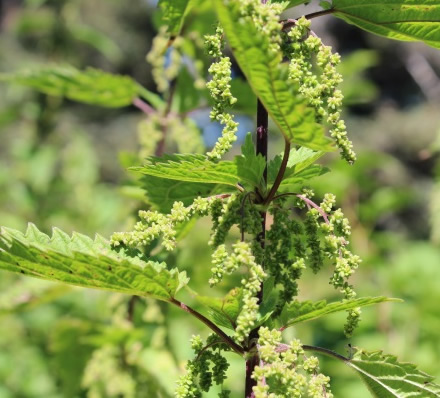Nettle

Botanical Name: Urtica gracilis or U. lyallii
Common Name: Nettle
Other Names: Uuqaayanaq (something that makes you burn all over)
Found in: Dry to moist, well-drained, open sites, meadows.. Thrives in poor soil.
Physical Characteristics: A tall rigid plant up to 40 inches tall with a slender square stem. The toothed, strongly vied, coarse-looking leaves have short stems and are placed opposite on the stems. They are long and narrow, broader at the base and have stinging hairs. The numerous tiny green flowers are on long drooping chains arising from the junction of the leaves and stem (Pratt 1991)
Nutritional Value: Contains significant amounts of protein, calcium, phosphorus, iron, magnesium, beta-carotene, along with vitamins A,C, D, and B complex,
Parts of the plant used: roots
When plant should be gathered: June – July
Plant applications: The stinging hairs contain amines — histamine, seratonin, acetylcholine — as well as glucoquinones and chlorophyll; Histamine [is] the component that induces the inflammatory cascade and leads to the symptoms. [It] acts like a local hormone [that] modulates the immune response. Fifty percent of allergy symptoms are caused by the release of histamine from mast cells. The allergen binds to the mast cell and the mast cell spills out inflammation and immune mediators which cause at first an acute/immediate response, and they in turn then release their own mediators in a delayed response that occurs hours later. The issue becomes a problem when this cycle repeats incessantly. Nettle affects this part of the problem. (The leaf is also anti-inflammatory.)
Reported Benefits: Arthritis, Constipation, general ill health, toothaches, stop childbirth hemorrhaging and tuberculosis. Stinging nettle contains natural antihistamines and anti-inflammatories (including quercetin), that open up constricted bronchial and nasal passages, helping to ease hay fever, and nose & sinus type allergy symptoms.
Preparation/Processing: Arthritis, toothaches: Nettle roots were used for arthritis and toothaches. Two methods were used. The first, the root was dug, cleaned and crushed, then warmed and placed on a hot rock. The patient would then drape a blanket over himself and inhale the steam which arose when the hot rock he had taken under the blanket with him was sprinkled with water. After a period of this treatment, the patient was given a bit of the warm nettle root to put on the tooth and sent to bed. The next morning, the tooth could be removed very easily in its entirety. The second method consisted of warming a piece of nettle root and placing it directly on the offending tooth. Then a small mat woven of fin nettle roots was placed on the cheek outside the sore tooth. After three or four applications of the mat, the tooth would be crumbly and easy to remove completely.
Constipation, stop child birth hemorrhaging tuberculosis: An infusion was drunk for constipation. Nettle used as a tonic for the female system goes back to the Native American women who used it throughout pregnancy and as a remedy to stop hemorrhaging during childbirth.
General ill health: Heated and crushed nettle roots were also employed to promote healing on an old injury or sprain that was once infected (Russell 1991)
I have used both the tincture and the dried herb as a tea with success. The tea works best when one starts to drink two-plus cups daily about two months before allergy season begins. The tincture dose is two droppers-full three times a day for most adults during allergy season. I also am a big proponent of eating fresh nettles.
Warning: Nettles should not be picked after flowering, and older leaves should not be used because they contain crystalline particles called cystoliths that are bad for the kidneys.
